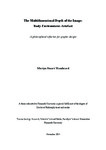The Multidimensional Depth of the Image: Body-Environment-Artefact (A philosophical reflection for graphic design)
| dc.contributor.supervisor | Punt, Michael | |
| dc.contributor.author | Woodward, Martyn Stuart | |
| dc.contributor.other | School of Art, Design and Architecture | en_US |
| dc.date.accessioned | 2014-11-11T11:26:18Z | |
| dc.date.available | 2014-11-11T11:26:18Z | |
| dc.date.issued | 2014 | |
| dc.identifier | 10131868 | en_US |
| dc.identifier.uri | http://hdl.handle.net/10026.1/3163 | |
| dc.description | Full version unavailable due to 3rd party copyright restrictions. | |
| dc.description.abstract |
The Multidimensional Depth of the Image: Body-Environment-Artefact Current discourses within cultural studies are re-iterating the limitations of language to adequately describe the affective domains of corporeality and materiality in the study of cultural artefacts. Within the discourse of graphic design, however, there remains an enduring focus placed upon models of language and communication to understand the meaning of designed materials. Rather than upholding a focus upon language, this thesis undertakes a theoretical investigation to extend the literature available to the discourse of graphic design to better understand how visual materials ‘come to mean’ within the experience of an embodied subject coupled to an affective environment. This thesis proposes an ontology of images that is emergent as a part of what, within the phenomenology of Merleau-Ponty, is describes as a mind-body-world system through which the ‘meaning’ of visual materials should be grounded. This thesis asks not ‘what’ visual materials mean but rather ‘how’ visual materials come to mean in terms of a complex relationship involving the embodied perceptual experience of the maker and the viewer that is immersed within an affective environment, what the thesis terms the multidimensional depth of the image. A phenomenological theory of art is extended to include a range of materials of popular visual culture to frame a study of how form and style come to mean qua the gestures of an embodied experience as coupled to an environment — a meaning that reciprocally emerges through the embodied experience of the work by the viewer. The environmental processes of which an embodied subject’s movements are coupled are brought into focus through enactive conceptions of mind within the cognitive sciences, describing how mind and meaning are emergent within an autopoietic organism-environment system. This provides a framework in which the affective dimensions of matter can be more fully understood as having a cognitive efficacy. Within this context, Material Engagement Theory (an approach within cognitive archaeology) is utilized to include a more focussed discussion of the affective domains of materials, objects, and artefacts and their role in the emergence of mind and meaning. | en_US |
| dc.description.sponsorship | HERA | en_US |
| dc.language.iso | en | en_US |
| dc.publisher | Plymouth University | en_US |
| dc.title | The Multidimensional Depth of the Image: Body-Environment-Artefact (A philosophical reflection for graphic design) | en_US |
| dc.type | Thesis | en_US |
| plymouth.version | Edited version | en_US |
| dc.identifier.doi | http://dx.doi.org/10.24382/1316 | |
| dc.identifier.doi | http://dx.doi.org/10.24382/1316 |
Files in this item
This item appears in the following Collection(s)
-
01 Research Theses Main Collection
Research Theses Main


